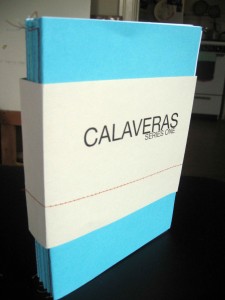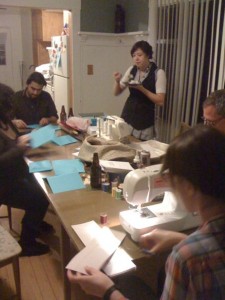Chapbook Spotlight: Calaveras

i heart chapbooks, especially chapbooks made with love. a new project that i am excited about is Calaveras, edited by sara mumolo & alisa heinzman. their first journal is quite innovative: it includes a series of 7 chapbooks (featuring poetry, essays, and interviews from 27 aesthetically and culturally diverse writers), wrapped together in a sleeve. i enjoy this format because it presents a lot of great work in easy to digest/carry chapbooks. buy your copy here.

q&a with the editors:
1) why did you start calaveras?
Alisa Heinzman (AH): I think our first conversation about doing this project together was really about bookmaking, what types of book design we like, and how fun it is to make books. I had the great pleasure of helping sew and put together some of Octopus Book's chapbooks when I was an undergraduate in Nebraska, and it's something I've missed the last couple years. When Sara mentioned she was interested in doing an editorial print project I was so excited. Something about handmade or homemade books feels very important to me right now.
Sara Mumolo (SM): Alisa and I worked together when I edited MARY magazine in graduate school. She was the Asst. Poetry Editor while I was there, and now she is the Poetry Editor there. The prospect of doing something together of our own originating, a publication without a specific history to succeed proved irresistible. My hope is that CALAVERAS gives readers pleasure and that it emphasizes community by the production of multiple books with poems in conversation.
2) what is the purpose of the magazine?
AH & SM: The purpose of the magazine is to endeavor to stay in flux with contemporary attitudes: to observe and cull. When speaking about reading contemporaneously in "What is the contemporary," Agamben says: ...the contemporary is not the one who, perceiving the darkness of the present, grasps a light that can never reach its destiny; he is also the one who, dividing and interpolating time, is capable of transforming it and putting it in relation with other times. He is able to read history in unforeseen ways, to "cite it" according to a necessity that does not arise in any way from his will, but from an exigency to which he cannot not respond. It is as if this invisible light that is the darkness of the present cast its shadow on the past, so that the past, touched by this shadow, acquired the ability to respond to the darkness of the now." Tall but seductive orders.
3) why did you choose the name 'calaveras'?
SM: A friend of mine, Pablo, left the bay area for graduate school a couple years ago. He's back now, but while he was away one year, in Mexico, he sent me a birthday card with a Calaveras skull on the front: Written on the bottom was the word CALAVERAS. I keep things—cards, poem broadsides, post-cards, and illustrations—that my friends or pen-pals send me in my desk. The desk is one of those white ones with a glass top, so one can slip things under it and look at them while writing, working reading, watching youtube. Good company. When choosing CALAVERAS for the name of a journal, we were thinking of a less specific name. We didn't want a name that immediately designated itself, like Panda Bear or something. A name that carried meaning in the world and in poetry was important, but a name that also had an image and context attached to it was sought. Over the past couple of years, I have been traveling to Mexico and Cuba more and more. The traditions of the Day of the Dead and All Soul’s Day are familiar to me, having grown up in a Catholic family. How I embrace these traditions now is not so literal in practice. I'm not following the terms of a institutional faith. So, the name of the journal is probably too personal, but I hope that it, at least, creates various yet specific meanings for readers as well.
4) how did you decide on the creative form & format?
AH: This is the first book layout I've done and it was exciting. We kept asking ourselves how to keep the layout as clear and simple as possible which led to a sans serif font and minimal amount of information on each page. Orderliness and readability seemed the most important thing, especially since we were lucky to have so many great authors and texts. Jake Gillespie, my husband, knows more about art and design than I do and was great for tips. How to bind was a tricky question, but we wanted to involve a sewing machine and in the end, it did all of the binding work. That machine's a real champ. Except for the covers, all of the printing was done on my little HP laser printer. It's great to have tools and technology that allow us to do as much as possible on our own. I'm hoping that the spark in this first series comes from the poems, and the interactions of poems in these book communities, and that the design does nothing to stand in the way. Maybe our future chapbooks will be a little more elaborate...we'll see!
SM: Transit, movement and ease: some of our favorite journals, Verse, Volt, Lana Turner etc., are sometimes too swollen to carry in my bag when I walk to work at Studio One in the morning. Or, if a friend rides a bike they can take one chapbook and leave the other six at home, waiting for the next trip. It makes taking half a book or one-seventh of a book possible. These options lend themselves to a life of movement, which seems to be the kind of life writers and readers must enter into more and more.
5) can people submit/subscribe/mailing list?
submit: A series of three single author chapbooks is our next project. We are accepting query letters and samples of work at our email: calaveras [dot] journal [at] gmail [dot] com
subscribe: Unable to promise anything to posterity, or perhaps unwilling, people can email us for a copy of the publication and payment will be handled via paypal.
mailing list: Yes! Send us an email and get on our list.
A new website donated by the designer Lindsey Baggette is forthcoming. We paid her with a gallon of milk and a turkey sandwich. Thank you Lindsey. When she asked about the design we wanted, I said: Something conjuring Calavera, Frank Stella or maybe Del Drago. Mainly, we hope it will be something that doesn't get in the way of the poems much like the books themselves.
6) what were you drinking while you made the chapbooks?
AH & SM: Simpler times; Lost Coast beers; Budweiser. Someone probably had a glass of water. Alisa made mini-calzones with goat cheese. She’s a swell cook.

7) what can we expect from calaveras in the future?
AH & SM: A series of three individual chapbooks is our next project. However, much like the first installment, things and ideas will change as we move forward. We'd like to print translations at some point. We hope CALAVERAS grows into a world citizen. However, we won't put pressure on it to be more than it can afford.
*
Alisa Heinzman lives in Oakland and attends Saint Mary's College of California. She co-curates CALAVERAS with Sara Mumolo and is the Poetry Editor for MARY Magazine. Her poems have appeared in Shampoo and The Benefactor Magazine.
Sara Mumolo works at Studio One Art Center and co-curates the Studio One Readings Series with Clay Banes. She co-curates CALAVERAS with Alisa Heinzman. Her poems have appeared or are forthcoming in Shampoo, Typo, Eleven Eleven, Mrs. Maybe, 1913: a journal of forms, Cannibal, West Wind Review & Action Yes, among others.
Craig Santos Perez is a native Chamoru (Chamorro) from the Pacific Island of Guåhan/Guam. He is the ...
Read Full Biography

